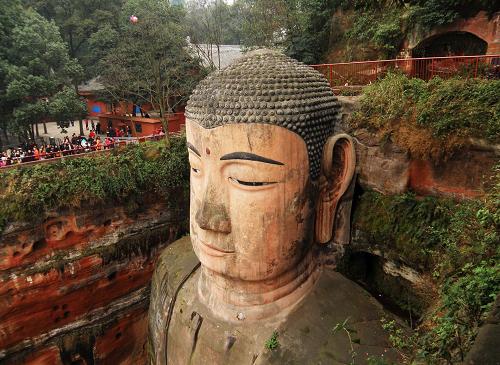Sichuan, in China’s western hinterland, covers most of the Sichuan Basin. Surrounded by mountains, it is situated at 26’03”-34’20” north latitude and 97’22”-110’10” east longitude with an area of 567,000 square kilometers, accounting for 5.1% of China’s total area. Sichuan is high in the west and low in the east in terms of topography. Generally speaking, the western part is plateaus and mountainous regions some 4,000 meters above sea level, while the eastern part features basin and hilly land with an elevation between 1,000 and 3,000 meters.
Here listed are 10 things you must see and never miss out in your Sichuan trip:
1. Chengdu Panda Breeding Research Center
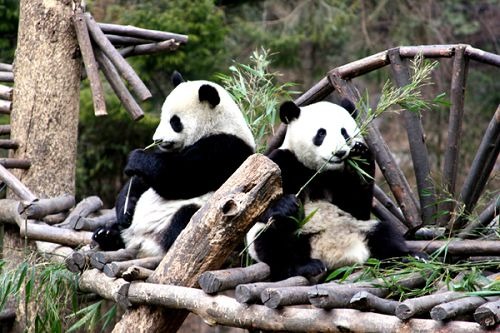
Located just 10km (miles) away from downtown Chengdu, the Chengdu Panda Breeding Research Center has been created and imitated the pandas’ natural habitat in order that they might have the best possible environment for rearing and breeding. The Center cares also for other rare and endangered wild animals. The necessary facilities for giant pandas have been completed and include a fodder room, sleeping quarters and a medical station. Additionally there is a Giant Panda Museum together with research laboratories and a training center.
♦ Join Chengdu Panda & Leshan Giant Buddha Day Tour – $95 per person.
2. The Leshan Giant Buddha
The Leshan Giant Buddha is a statue of Maitreya (a Bodhisattva usually represented as a very stout monk with a broad smile on his face and with his naked breast and paunch exposed to view) in sitting posture. The Buddha is located to the east of Leshan City, at the confluence of three rivers. The statue makes itself the most renowned scenic spot in Leshan City. Begun in the year 713 in the Tang Dynasty, and finished in the year 803, the statue took people more than 90 years to carve. As the biggest carved stone Buddha in the world, Leshan Giant Buddha is featured in poetry, song and story. (Interested in seeing lovely Panda? Our Kung fu Panda Tour will take you to enjoy both Chinese Kung fu in Shaolin Temple and lovely Panda in Chengdu.)
♦ Join Chengdu Panda & Leshan Giant Buddha Day Tour – $90 per person.
3. Mt. Emei
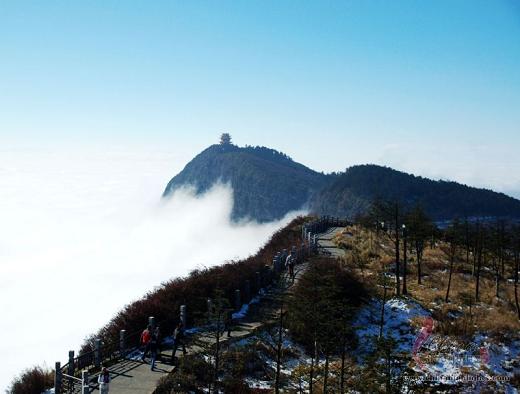
Located 156 kilometers away from Chengdu city, the area of Mt. Emei is of exceptional cultural significance, since it is the place where Buddhism first became established on Chinese territory and from where it spread widely throughout the east. It is also an area of natural beauty into which the human element has been integrated and natural criterion for its high plant species diversity with a large number of endemic species. It also underlined the importance of the link between the tangible and intangible, the natural and the cultural. Our Mount Emei and Leshan tour will take you to visit this fantastic place.
4. Dujiangyan Irrigation Project In China
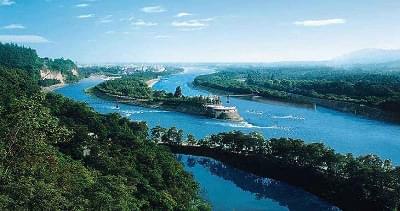
Chengdu is always praised as the Tian Fu Zhi Guo, which means ‘Nature’s Storehouse’. Over 2,200 years ago, the city was threatened by the frequent floods caused by flooding of the Minjiang River (a tributary of the Yangtze River). Li Bing, a local official of Sichuan Province at that time, together with his son, decided to construct an irrigation system on the Minjiang River to prevent flooding. After a lengthy study and a lot of hard work by the local people, the great Dujiangyan Irrigation Project was completed. Since then, the Chengdu Plain has been free of flooding and the people have been living peacefully and affluently. Now, the project is honored as the ‘Treasure of Sichuan’, which still plays a crucial role in draining off floodwater, irrigating farms and providing water resources for more than 50 cities in the province.
♦ Dujiangyan Irrigation System and Mount Qingcheng Day Tour
5. Sanxingdui (Three-Star Piles) Museum
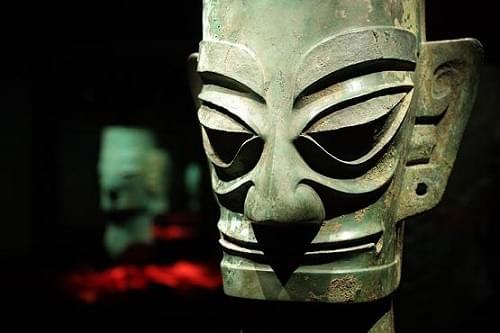
Sanxingdui Museum is located in Northeast of Sanxingdu archeological site, west of the famous cultural city of Guanghan, on the bank of Jian River (commonly called Yazi River). The discovery of Sanxingdui Relic is heart-stirring but some cultural relics remain enigmatic. Sanxingdui is a cultural relic of the ancient Shu (Sichuan). It is an important archeological discovery which changed the people’s understanding of ancient history and culture. If you want to visit a place to know more about Chinese Shu (Sichuan) culture, make it this one, for the civilization shown by the cultural relics can be called a true wonder.
6. Jiuzhaigou
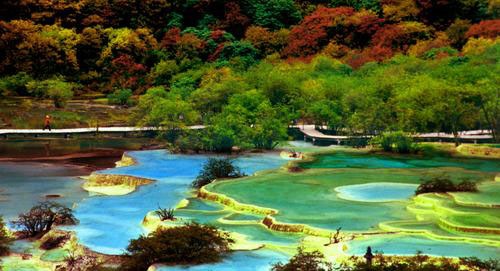
Jiuzhaigou has an unusual ecosystem with dozens of pristine lakes, waterfalls, forests and rare animals. There goes a saying: no mountain is worth seeing after Mt. Huangshan and no other water will be of interest after Jiuzhaigou. If there are ‘fairylands’ in the world, Jiuzhaigou is certainly one of them. This site has been designated as a UNESCO World Heritage Site.
7. The Huanglong Scenic and Historic Interest Area
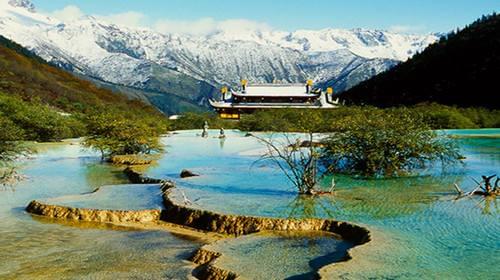
The Huanglong Scenic and Historic Interest Area, located in Songpan County, is another UNESCO World Heritage Site. It is noted for its colourful waters, lakes, hot springs, snow-capped mountains, valleys and forest. It is another must see for visitors coming to Jiuzhaigou Valley.
♦ 3 days Jiuzhaigou and Huanglong tour
8. Wuhou Memorial Temple (Wuhou Ci)
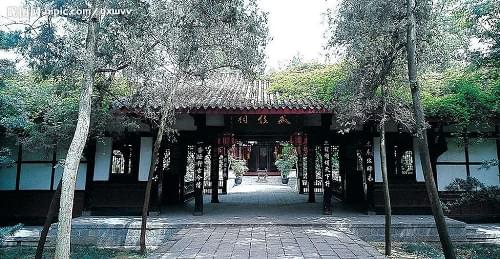
Located in the south of Chengdu, Wuhou (Marquis) Temple is a famous historical site dedicated to the memory of both Liu Bei (161-223 A.D), Emperor of the Kingdom of Shu in the Three Kingdoms period (220-280 A.D), and Zhuge Liang (181-234 A.D), Prime Minister of the kingdom. The temple consists of Liu Bei Hall, Zhuge Liang Hall and Hui Ling Tomb, plus some precious cultural relics, such as the “Statement at Departure” composed by Zhuge Liang and with the calligraphy of Yuefei, Longzhong Couplet also written by Zhuge Liang.
9. Mt. Qingcheng
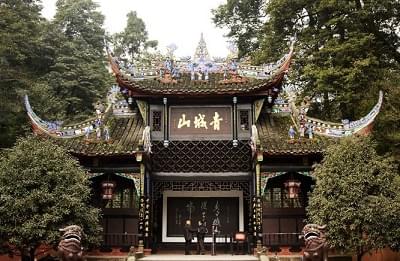
Located in the southwest of the Dujiangyan Irrigation Project of China in Sichuan Province, is one of the most fa mous Taoist mountains in China. It is also a very attractive and intriguing scenic spot that is covered by luxuriant and verdant trees. The mountain, which is surrounded by numerous peaks and is shaped like a city, is dubbed ‘the most peaceful and secluded mountain under heaven’ and combines perfectly with its evergreen scenery.
♦ Dujiangyan Irrigation System and Mount Qingcheng Day Tour
10. Jinli Street
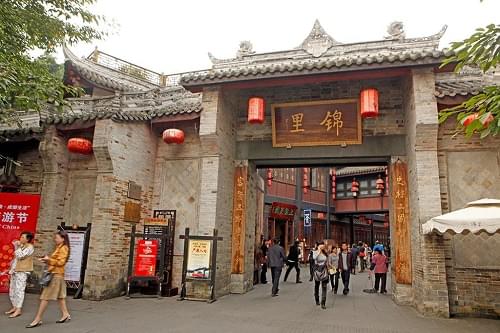
Jinli was the first street to demonstrate the construction style in west Sichuan backing to the Qin Dynasty (221BC- 206BC). It was in ancient times one of the busiest of commercial boulevards of the Shu Kingdom during the Three Kingdoms Period (220-280). The whole length of the street is about 350 meters. When walking in this street you can feel as if you were back to the old time in Chengdu.
Update September 20th, 2017

